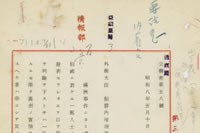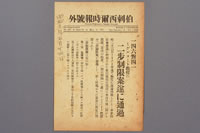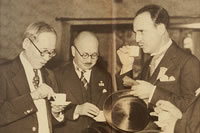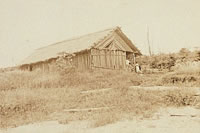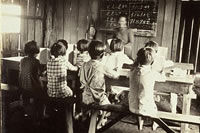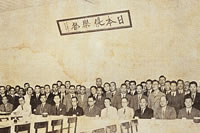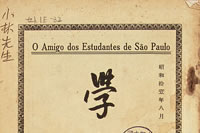Establishment of the quota system and movements for Japanese immigrants exclusion
Increasing anti-Japanese sentiment
When under the new government established by Getúlio Vargas' coup, unemployment increased as a result of the Great Depression in October 1930, nationalism rose and sympathy and support for exclusion of foreigners spread among the population, and the immigration of foreign nationals was severely restricted in the same year. But since Japanese alone were exempted from the immigration restriction, the number of Japanese immigrants was far greater than those of other immigrants and their presence became more conspicuous.
In addition, after the Manchuria Incident in 1931, antipathy Japan's actions grew towards also in Brazil. In particular, when the news from Tokyo, on April 8, 1933, reporting that the Japanese military would ship emigrants who were to be shipped to Brazil to Manchuria, was published in a Portuguese-language newspaper in Rio de Janeiro, those sympathetic to Japan felt unpleasant since they thought that Japan had abandoned Brazil for Manchuria, while those who supported to the Japanese exclusion found Japan’s aggressive intent behind the shipment of such large number of emigrants to Brazi and increased a degree of wariness towards Japan.
In these circumstances a lively discussion on Japanese exclusion had come to take place.
Passing of the two percent limit clause
When the drafting of a new constitution began on November 30, 1933 in the Constituent Assembly, four amendments were proposed to restrict the entry of immigrants according to the ethnic groups, substantially to insert a clause on the restriction of Japanese immigrants. The reasons given to support these proposals were that Japanese immigrants were not apt to assimilate, that the addition of Asian and African ethnicities to Brazil's ethnic composition was undesirable, and that there was a risk of Brazil suffering the same fate as Manchuria. Although there had been much discussions with various arguments raised for or against the proposals, finally the passing of the amendment clause proposed by professor Miguel de Oliveira Couto, a noted anti-Japanese figure, which should restrict the number of immigrants from each country to 2% of the total number of the immigrants who had settled in the country for the 50 years between 1884 and 1933 was ratified by the Assembly on May 24, 1924. Accordingly, the number of Japanese immigrants was legally restricted to 2,849, 2% of the total number of 142,457.
This new rule, however, was not immediately applied and since a measure was taken to take no accout of the number of those under 14 years of age, some 5,000 Japanese immigrants entered the country from then onwards by 1937.
Visit of the economic mission to Brazil
In Japan the passing of the two percent limit clause was attributed to absence of any private-sector diplomacy such as academic, artistic, religious, economic or sports diplomacy between Japan and Brazil, and the Japan Chamber of Commerce and Industry dispatched an economic mission to Brazil from May to June 1935 (headed by Hachisaburo Hirao, director of the Federation of Overseas Emigrant Cooperatives) in order to promote goodwill and trade relations between the two countries.
Although Representatives of the the Japan Cotton Textile Promotion Committee already visited Brazil in 1934 and the committee had already begun research, it was with the visit of the Economic Mission that channels were opened for the purchase and the import of cotton grown and produced by Japanese immigrants in Brazil. Consequently, export of cotton from Brazil to Japan rapidly increased from 1936 until the outbreak of the Pacific War. The economic mission was thus successful in regards to the purchase of cotton.
Termination of the Amazon concession agreements
The building of these favorable economic ties did not, however, led to weakening trends in Japanese exclusion. Article 130 of the new constitution described that the approval of the Senate should be required to enter into any agreement involving a concession (gratuitous grant) of one or more hectares of land, and in March 1936, the agreement for a concession of land between the State of Amazonas and the Amazonia Industrial Research Center was submitted to the Federal Senate by the State. From then onwards, an anti-Japanese group, the Society of the Friends of Alberto Torres, had begun movements against the concession based on yellow peril ideology, and in a Portuguese language newspaper an inflammatory anti-Japanese article was placed which reported that the Japanese had planned to build a naval base in the Amazon on the lookout for the Panama Canal. Arguments raised for and against the concession, there had been many long discussions inside and outside the National Congress and at last on August 24, 1936, the Federal Senate plenary session adopted unanimously the report of the Federal Senate Coordinating Committee which suggested that the State Government should dismiss the application for a concession of land on the grounds of national security.
-
Articles in newspapers / magazines
-
 Trends in Japanese exclusion after the Manchuria Incident and measures to weaken the trends
Trends in Japanese exclusion after the Manchuria Incident and measures to weaken the trends -
Articles in newspapers / magazines
-
 Japanese-language newspaper special edition announcing the passing of the "two percent limit clause"
Japanese-language newspaper special edition announcing the passing of the "two percent limit clause" -
Articles in newspapers / magazines
Statement by Consul General of Japan in Brazil, Iwataro Uchiyama
-
 Hachisaburo Hirao and Iwataro Uchiyama
Hachisaburo Hirao and Iwataro Uchiyama -
Articles in newspapers / magazines
Issue on the concession to the Amazonia Industrial Research Center debated in the Senate
Prohibition on Japanese language education
Prohibition on the teaching of foreign languages to children of 10 years of age or younger
The amendments to the Education Law of São Paulo State which were enacted in December 1920 prohibited the teaching of foreign languages to children of 10 years of age and younger at private schools (foreign languages were not taught in public schools), at Japanese settlements, however, the majority of classes still continued to be taught in Japanese.
In October 1928, an incident occurred. The education authority of São Paulo State ordered the closure of dozens elementary schools around the Noroeste line on the grounds that in those schools there are no Brazilian teachers and that they had taught Japanese to students 10 years old and younger. Afterwards some unlicensed Japanese schools were licensed as Brazilian elementary schools by the state authority, and as a result were able to teach Japanese language classes supplementarily.
Closure of Japanese language schools
In September 1936, after the superintendent of education of São Paulo State visited schools in Bastos and other outlying regions, his observation was published in the São Paulo city newspaper "Folha da Manha", saying that he was extremely dissatisfied with the level of Portuguese language ability of Japanese children. Other newspapers cited this article and called into question the lack of assimilation of Japanese immigrants. In response, the Association for the Promotion of Japanese Education in Brazil immediately deliberated on countermeasures, and on October 15 adopted an educational policy of "Brazil first, Japan second" and agreed on prohibition of teaching Japanese to children of 10 years of age and younger as a general rule.
Brazilian Government policies based on nationalism, however, continued to develop and on May 4, 1938, the "Decreto-Lei N. 406. Dispoe sobre entrada de estrangeiros no territorio national" (Decree-Law N. 406. Provisions on the entry of foreigners into the national territory) was issued, prohibiting foreign language instruction for students 14 years of age and younger at schools in rural areas and required a school teacher to be a native of Brazil and the law came into effect on December 21, 1938. As a result, all Japanese schools in rural areas (regions outside the federal and state capitals and ports of entry for foreign visitors arriving in the county. In the State of São Paulo the "rural areas" meant all areas other than San Paulo City and Santos) was forced to shut down.
After the closure of Japanese language schools, Japanese language instruction was mainly carried out through homeschooling or by circuit teachers. However, since each circuit teacher’s class was conspicuously attended by 4 or 5 children, Brazilian neigbors often tipped off police about such a class as an illegal Japanese school and the class was exposed by the Brazilian authorities.
There were also those who had given up educating their children in Brazil and sent them back to Japan to be educated.
-
Articles in newspapers / magazines
Problem on the suspension of operations of Japanese elementary schools
-
 Policies of the Association for the Promotion of Japanese Education in Brazil after the closure of Japanese language schools
Policies of the Association for the Promotion of Japanese Education in Brazil after the closure of Japanese language schools -
 Elementary school at a colony
Elementary school at a colony
-
 Japanese language class taught by a circuit teacher
Japanese language class taught by a circuit teacher -
Articles in newspapers / magazines
Controversy over remarks of military attaché Nakanishi about the problem of Nisei education
-
 2nd conference of chairmen of school councils
2nd conference of chairmen of school councils
Growth of Nisei
Around 1935 between 150 and 200 people of Japanese descent enrolled in secondary schools in São Paulo City and almost 10 persons enrolled in universities. On October 21, 1934, the São Paulo Japanese Student League was founded as a social group for students of Japanese descent enrolled in secondary schools and higher education institutions..
Among Nisei (the second generation of Japanese immigrants) there were differences of opinion according to the frequency and depth of contacts with Brazilian society when they grew up. Those Nisei brought up in Japanese settlements in outlying regions felt affection for the land, Brazil, but they also spoke Japanese well and had inherited Issei's (the first generation) patriotism for Japan. Meanwhile, those brought up in urban areas with frequent and deep contacts with Brazilian society, respected Japan as their parents’ country of birth, but thought that Japan was nothing more than their parents’ country of birth and considered themselves Brazilian and loved Brazil.
Among those Nisei who held dual nationality, some travelled to Japan and enlisted in the military and some joined the Brazilian military and were sent to Italy after Brazil joined the war (on August 22, 1942 with the declaration of war against the Axis nations).
-
Articles in newspapers / magazines
-
 Self-awareness as Nisei Brazilians
Self-awareness as Nisei Brazilians

